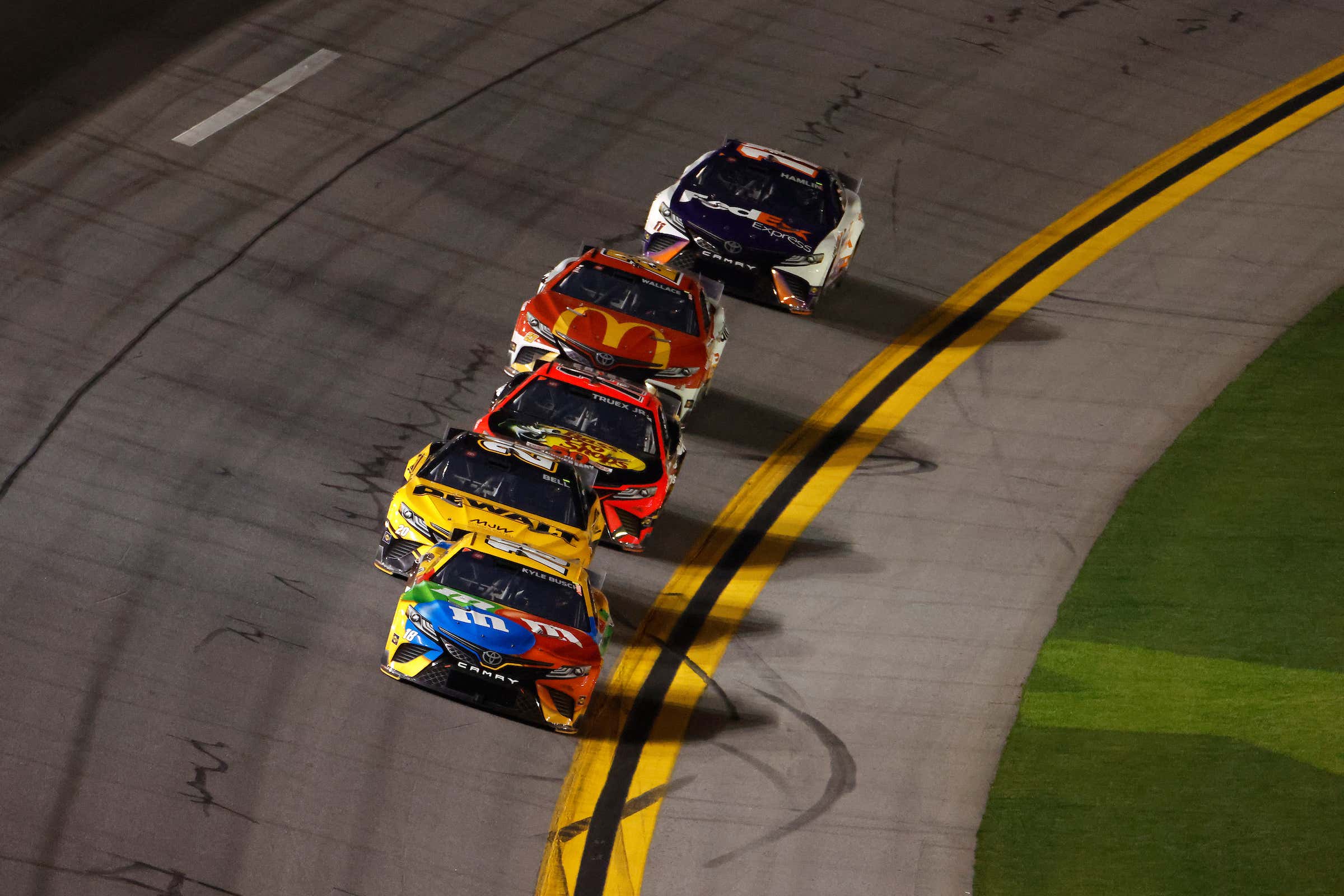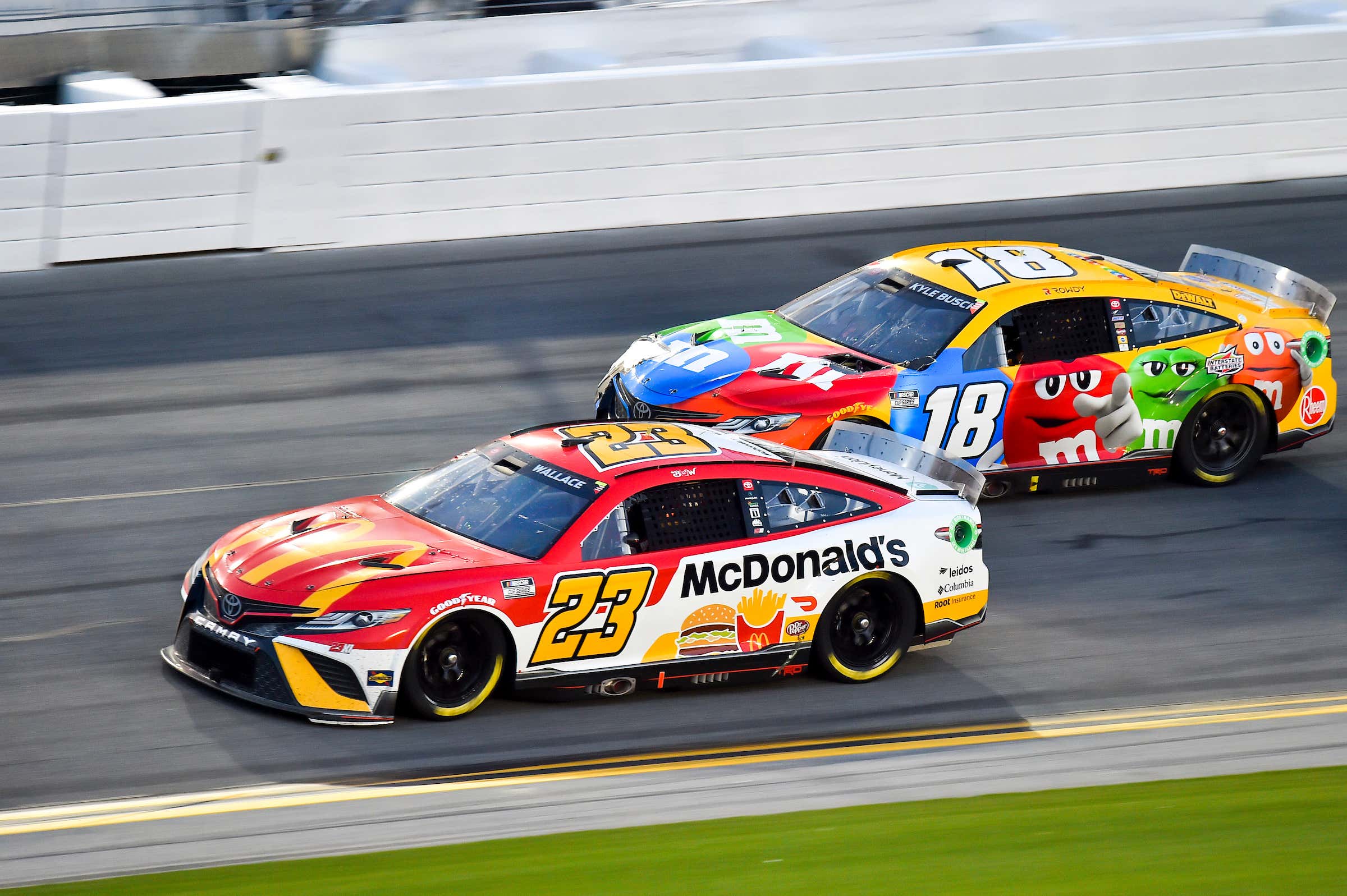Here’s Why Toyota Goes All-In on NASCAR
It’s sometimes tough to make a business case for racing, especially if you’re an automaker that doesn’t build high-end performance cars. You’d imagine that’d be doubly true for a manufacturer whose economy sedan sales far outweigh its sports car volume, in a series that’s rowdier than any of its products even pretend to be. Toyota’s been doing it in NASCAR for a dang long time, though, and it isn’t going away, even as the sport ushers in its Next Gen cars and the entire set of costs and regulations that come with them.
Since it’s only ever competed against domestic manufacturers in NASCAR, Toyota has been targeted by some of the sport’s fanbase—and I’d say unrightfully so—as a poser in the garage. People think that since Toyota doesn’t have a Camaro- or Mustang-equivalent in its lineup, it must not be serious about stock car racing. It’s got roughly two decades of track experience to prove otherwise, however, and it continues to build on that with its flagship team Joe Gibbs Racing and the uprising 23XI outfit that’s co-owned by Michael Jordan and Denny Hamlin.

The Drive / Caleb Jacobs
It goes beyond the Cup Series, too. Toyota has long taken a vertical approach to its stock car racing system that starts in grassroots motorsports and goes all the way up to the big time like we saw at Sunday’s Daytona 500. The manufacturer supports racers in the early stages of their careers, even before they enter one of NASCAR’s three national series. Twenty-year-old Christian Eckes is one example, and The Drive talked with him over the weekend at Daytona prior to Friday night’s Truck Series race.
A few years back, he was racing in ARCA and winning the championship there in a Camry. Now he finds himself in a 2022 Tundra TRD Pro race truck that’s way more traditional than what we’re now seeing in the Cup Series.
“I think their commitment to success is like none other,” Eckes explained of Toyota. “They provide so many resources for us—the simulator, the gym they built—everything they do, they want to succeed with confidence. It’s been really special to be a part of the Toyota program, I’m in my sixth year now.”
If he’s not in a NASCAR Tundra, Eckes is probably at the Toyota Racing Development simulator he mentioned in Salisbury, North Carolina. It’s there that he and the rest of Toyota’s huge team of drivers keep their skills sharp, practicing on the extensive number of tracks they visit throughout NASCAR’s grueling schedule. Chevy and Ford both have sims of their own, but Toyota was pretty much the first to institute such tech as part of its stock car training regiment in the early 2010s.
The TRD facility is roughly 40 miles northeast of Charlotte, and it’s also where you’ll find the manufacturer’s wind tunnel. Aerodynamics are at least as important, if not even more so, to a NASCAR stock car’s success as horsepower. Toyota treats it appropriately, then, especially as the Camry body for this Next Gen car is refined at the beginning of the 2022 season.

Toyota Racing
Kurt Busch in the No. 45 Toyota Camry Cup car.
Kurt Busch is new to Toyota, but he isn’t new to NASCAR. His first Cup Series race was in 2000 and he’s raced for every major manufacturer in the series—Chevy, Ford, and yes, even Dodge. He won the 2004 Cup Series title as well as the 2017 Daytona 500, meaning he’s familiar with top-spec machinery and top-grade competitors, from a team and automaker perspective. Toyota’s unrelenting attention to detail and data is what’s stood out to him in his short time with 23XI Racing.
“There’s this whole aura of how Toyota arrives at the track and now being part of it, it’s all coming true on what I thought—on the depth of everyone involved. Right after this, I’m meeting with one of the top engine builders to question how the [Duel] race went last night. That was just a random text that came on my phone, like ‘Yes, sir. I’ll be right there.’ And so it’s the depth that I see with Toyota.”

Toyota Racing
At 43 years old, Busch isn’t looking to waste time. And knowing the capitalist suave his boss MJ possesses, it wouldn’t make sense for either of them to partner with a company that’s only half-in. That’s never been the case, as Busch explains.
“Ford had that family aspect with Edsel Ford and the way they operated. Chevy with Jim Campbell and the way he worked his group, they were there really pushing hard with branding and advertising. But yet the Toyota group, with the simulator, wind tunnel reports, and the race reports, everything’s just gone to another level.”
This type of enthusiasm carries all the way up to TRD’s executives, like President David Wilson and Technical Director Andy Graves. These two are extremely involved in the cars’ development from a mechanical standpoint, even though they’re referred to as suits. They’re engineers, really and truthfully. In a roundtable interview, they both told me about aerodynamic and powertrain concepts that average corporate execs wouldn’t get, and Wilson says that started early.
“As a young engineer, I used to chase [Toyota off-road racing champ] Ivan Stewart down the Baja peninsula with a laptop,” he explained. That was 1989; flash forward to now and he’s been atop TRD for eight years. In that time, Wilson’s been able to propel Toyota’s racing efforts higher than ever, and in more than just stock car racing. Of course, three Cup Series championships during the 2010s was nice, too.

Toyota Racing
Wilson believes what Toyota does in racing directly affects the product that’s available to customers. That’s not to say we’ll soon see a V8-powered Camry, but in terms of design and reputation, TRD is undeniably influential.
“What I encourage people to do is to Google ‘2000 model year Camry’ and put it side by side with a 2022 Camry. You’ll be amazed,” Wilson explained. “My inference is that there has absolutely been an influence on the styling of our production car because of the car we’re racing.”
Now imagine if they’d race a Supra in the Cup Series.
“What I’ll say a little more definitively is from a production perspective, where TRD has made the most hay is clearly with the trucks and SUVs. I think the first-gen TRD off-road-branded truck was 1996. Today, over 50 percent of the trucks we sell have a TRD badge on it and that’s something we’re awfully proud of as our success on the racetrack has continued to grow, it’s really supported our credibility and given that brand a real lift.”
Of course, off-road trucks aren’t sports cars, and they definitely don’t share much with the Camry Cup car. But guess what most NASCAR fans drive every day? Pickups. See, It’s all coming together.
So next time you see a Toyota racing Chevys and Fords on a Sunday, don’t second guess it. There’s a legit team with real racers behind each of the six Camry Cup cars, not to mention all the Supras in the Xfinity Series and the Tundras in the Truck Series. NASCAR is Toyota’s home and it’s not going anywhere, even if it moves further away from its, how do I say, traditional roots. If anything, it’s even more interested in what’s next for the sport.

Toyota Racing
Got a tip or question for the author? Contact them directly: [email protected]



.jpg)

